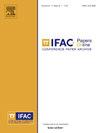Numerical Diffusion and its Impact on System-Identification for an Industrial Heating Process
Q3 Engineering
引用次数: 0
Abstract
This paper deals with system-identification for a distributed parameter heating process where a solid substrate is moving through a spatially extended heating zone and heated up by applying hot air to its surface. The temperature distribution inside the substrate is modeled in a spatial plane, where heat conduction is considered in the direction, perpendicular to the direction of movement. In contrast to previous work, where scalar model parameters (e.g. the thermal parameters of the substrate) have been identified, here, the quantities for the heat transfer (heat transfer coefficient and air temperature) are identified as functions yielding a significantly improved fit to the measurement data. This improved system-identification is performed for two early-lumping modeling approaches, which differ in the way the advection term in the governing Partial Differential Equation is discretized: one uses Eulerian coordinates, where the computational grid is stationary, whereas the second employs Lagrangian coordinates where the grid is moving with the substrate. The differences of the two approaches are discussed with the main focus on numerical diffusion. Especially its impact on the system-identification is investigated: although the fit to the measurement is comparably good in both cases, very different solutions are obtained for the identified functions which, we argue, is due to the optimizer counteracting the smoothing effect of numerical diffusion.
数值扩散及其对工业加热过程系统辨识的影响
本文讨论了分布参数加热过程的系统识别,其中固体基材通过空间扩展的加热区移动并通过在其表面施加热空气进行加热。基材内部的温度分布在空间平面上建模,其中热传导是在垂直于运动方向的方向上考虑的。与以前的工作相反,在标量模型参数(例如基材的热参数)已经确定,在这里,传热量(传热系数和空气温度)被确定为函数,产生与测量数据的显著拟合。这种改进的系统识别是为两种早期集总建模方法执行的,它们的不同之处在于控制偏微分方程中的平流项被离散化的方式:一种使用欧拉坐标,其中计算网格是静止的,而第二种使用拉格朗日坐标,其中网格随着基底移动。讨论了这两种方法的区别,主要集中在数值扩散上。特别是它对系统识别的影响进行了研究:尽管在两种情况下与测量的拟合都相当好,但对于识别的函数获得了非常不同的解,我们认为这是由于优化器抵消了数值扩散的平滑效应。
本文章由计算机程序翻译,如有差异,请以英文原文为准。
求助全文
约1分钟内获得全文
求助全文
来源期刊

IFAC-PapersOnLine
Engineering-Control and Systems Engineering
CiteScore
1.70
自引率
0.00%
发文量
1122
期刊介绍:
All papers from IFAC meetings are published, in partnership with Elsevier, the IFAC Publisher, in theIFAC-PapersOnLine proceedings series hosted at the ScienceDirect web service. This series includes papers previously published in the IFAC website.The main features of the IFAC-PapersOnLine series are: -Online archive including papers from IFAC Symposia, Congresses, Conferences, and most Workshops. -All papers accepted at the meeting are published in PDF format - searchable and citable. -All papers published on the web site can be cited using the IFAC PapersOnLine ISSN and the individual paper DOI (Digital Object Identifier). The site is Open Access in nature - no charge is made to individuals for reading or downloading. Copyright of all papers belongs to IFAC and must be referenced if derivative journal papers are produced from the conference papers. All papers published in IFAC-PapersOnLine have undergone a peer review selection process according to the IFAC rules.
 求助内容:
求助内容: 应助结果提醒方式:
应助结果提醒方式:


